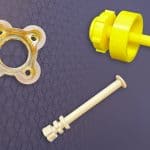Keeping aircraft in “PEEK” condition for flight
High-temperature lightweight materials are critical to aircraft applications. Aircraft engines can reach temperatures up to 3812 Fahrenheit (2100 Celsius); vehicles at higher altitudes undergo extreme temperature changes compared to ground operations. Aircraft components and equipment must be able to withstand these temperatures in addition to high pressure, vibrations, impact, and corrosion to maintain reliable, safe operation. Among the advanced materials on the market, polyetheretherketone (PEEK) is a top material choice for aerospace and defense critical component applications.
AIP has over 39 years of experience machining complex tight tolerance components from thermoplastics like Polyetheretherketone (PEEK). In this insightful technical brief, we discuss the advantages of PEEK for thermal applications in aviation component manufacturing.
PEEK for Machined Aircraft Components
Industrial-grade PEEK is a thermoplastic known for its flame retardance, abrasion resistance, and high impact strength. It is known for maintaining its mechanical properties at elevated temperatures, which makes it an ideal candidate for aircraft components.
Key Properties
- Abrasion Resistance
- Chemical Resistance
- High Ductility
- High Elongation
- Hydrolysis Resistance
- Low Outgassing
- Thermal Stability
PEEK’s diversity of aerospace applications includes:
- Flight control components
- Fuel system components
- Aircraft interiors
- Engine and aerodynamic-related components
3 Benefits of PEEK’s thermal capabilities for aerospace materials
There are numerous reasons to choose PEEK for aircraft components. Aircraft often undergo extreme temperature fluctuations due to extreme altitude changes. Therefore, it’s critical for aircraft components to maintain their functionality and integrity in various operational environments.
While metals play a key role in aviation materials, especially structurally, they can’t compete with thermoplastics in several categories, including thermal and electrical isolation and lightweight/high-heat performance. There are three reasons PEEK is a better choice than metals for thermal applications:
Insulating and Radar Absorbent: Military vessels and aircraft rely on stealth to carry out critical missions and projects. Thermoplastics like PEEK are naturally radar-absorbent as well as thermally and electrically insulating. These properties allow for flame retardance, radar transmissivity, weight reduction, and insulating properties all combined in one!
Corrosion-Resistant: Exposure to harsh chemicals is inevitable whether on a plane, drone, or space vehicle. PEEK handles high temperatures of 480 Fahrenheit (249 Celsius) continuously and maintains functionality in hostile environments during exposure to water, chemicals, aircraft fuels, and steam. This quality alone can increase the lifespan of an aircraft, save operators on costly maintenance services, and reduce MRO downtime for more operational time per aircraft per year.
Flame and Smoke Resistances: PEEK carries a V-O flammability rating and exhibits very low smoke and toxic gas emissions when exposed to flame. Therefore, PEEK is an ideal candidate for interior aircraft components. Today’s commercial jet engines can reach temperatures as high as 3,092 degrees Fahrenheit (1,700 Celcius). Under such a heat index, aircraft materials have to maintain functionality, and PEEK is an excellent material for numerous applications within PEEK’s thermal capability range.
PEEK is a material choice over metal not only for its thermal properties, but as a lightweight material, it shaves off excess weight that would have otherwise increased the fuel usage in an aircraft. It’s estimated that operators can make weight savings up to 60 percent When converting metallic components to high-performance polymers such as PEEK. This translates to lower annual fuel costs, reduced emissions, lower carbon footprint, and extended flight ranges.
Choosing a machining facility for your aerospace manufacturing
PEEK and other thermoplastics continue to gain attention as a material choice for high-performance aircraft and aerospace manufacturing applications. It’s important to not only focus on the thermal properties of the material but the overall capabilities of a material and how it could fit into your design.
When researching machining shops for your performance plastic aerospace application, look for a manufacturer that machines only plastics. Some manufacturers machine both metals and plastics on the same machine, and that can contaminate a precision polymer machined part with micro metallic fragments.
Also, ensure the facility is audited and registered to the correct regulatory standards, including CMMC, ITAR, FDA, and AS9100D. Most OEMs work under stringent regulations, especially those affiliated with government operations. It’s critical to have a shop that communicates with you every step of the machining process and follows these strict regulations.
If you are looking for thermoplastics like PEEK for an aerospace project, AIP’s engineers offer design consultation, precision plastics machining expertise, and on-time project delivery. For over 39 years, AIP has worked with performance thermoplastics from PEEK, VESPEL, TORLON, RADEL, TEFLON, and ULTEM to provide highly precise and extremely resilient machined parts. One final key component is to assure your polymer machining partner is capable and well experienced in thermal stress reliving of polymer materials. There is more to machining mission-critical polymer aerospace components than just the machining! Contact AIP for a consultation on your mission-critical project.
Supportive Information
Aerospace Materials
Peek Variants Guide
Thermoplastics make a big difference in weight savings for aerospace materials. See how:






